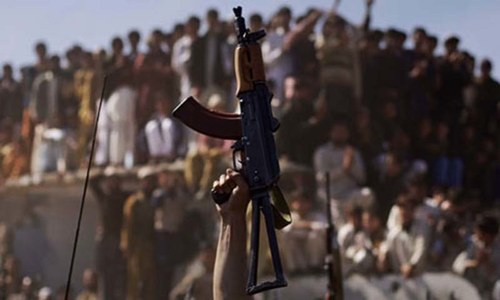VIOLENCE in Kurram has spiked in frequency and magnitude recently. Fresh clashes erupted on Nov 21, when passenger vehicles were ambushed near Mandori.
Forty-four persons lost their lives, including women and children. In revenge attacks, Baggan market in Lower Kurram was burnt to ashes with a further loss of 40 people. Prior to this sectarian carnage, 49 persons were killed in clashes in July, 46 in September and 16 in October.
To understand the current crisis, the peculiar characteristics of the Kurram region merit an in-depth analysis. Firstly, Kurram remained strategically important during the Great Game because of its unique geography jutting into Afghanistan — also referred to as the ‘Parrot’s Beak’ — and thus located at the shortest distance from Kabul.
Not surprisingly, Kurram became a launching pad for the mujahideen into Afghanistan in the 1980s. Jaji and Tora Bora, bordering Kurram, remained the headquarters of Osama Bin Laden where he established the training camp, mas’ada — the lion’s den — for his fighters. OBL and Sufi Muhammad escaped via Parachinar after the US invasion post 9/11.
Secondly, Kurram district has a history of sectarian tensions dating back to before partition. In 1938, when sectarian clashes flared up in Lucknow, some tribesmen of Kurram intended to proceed there to support their respective sect but their movement was resisted in Kurram by the rival sect and thus the foundation of sectarian tensions was laid in Kurram.
After partition, the first sectarian conflict erupted in 1961 at Sadda during the Muharram procession. In 1971, clashes took place over the construction of a mosque minaret in Parachinar. Subsequently, recurring sectarian conflicts were witnessed during 1987, 1996, 2007, 2008, 2010, 2011, 2020, 2022 and 2023 for various reasons.
Thirdly, in the merged district of Kurram, unresolved disputes frequently morph into sectarian strife. Although disputes exist between the Mehsud and Wazir tribes in South Waziristan and between the Dawar and Wazir tribes in North Waziristan, they rarely spread beyond a certain area due to the absence of sectarian underpinnings. However, in Kurram district, unresolved disputes of land, forest, water and minerals flare up when sectarian tendencies blend with the clashes.
Currently, major land disputes exist either within one common area like Balishkhel, Bushera and Taida or between two rival villages like Pewar (Shia) and Gido (Sunni); and Ghoz Garhi (Sunni) and Kunj Alizai (Shia). Similarly, a water dispute exists between the Kharoti (Sunni) and Pewar villages and a forest dispute between Badama (Shia) and the Parachamkani (Sunni) villages.
The way forward in Kurram entails both short- and long-term solutions.
Interestingly, the British carried out the first land settlement in Kurram in 1901, followed by a second one in 1943-44. After an interlude of many decades, the KP government established a Land Commission in 2021 for the settlement of the unmeasured disputed land (shamilat) of Gido, Pewar, Boshera, Dandar, and Ghoz Gari in Upper Kurram. The areas identified for settlement in Lower Kurram include the Balishkhel, Shurko and Sadda shamilat. Until now, 500,000 kanals (62,500 acres) of 33 mouzas are settled and digitised and the report sent to the provincial government for implementation.
Fourthly, the demography of Kurram district is unique. It is the only district of KP where the Shia community is in a majority. This majority is more pronounced in Upper Kurram and its headquarters Parachinar. However, movement from Upper Kurram to the rest of the province is possible through Lower Kurram which is predominantly Sunni. This route remains closed during violence. Residents previously used to travel via Gardez and Nangarhar to reach Peshawar in Pakistan.
Fifthly, two important events of 1979 — the Soviet invasion of Afghanistan and the revolution in Iran — have influenced the sectarian landscape by providing an ideological foundation. Moreover, the conflict zones of Syria, Afghanistan and Iraq have upgraded skills of violence locally. Not only have war-hardened fighters of these conflict zones displayed their skills during violence in Kurram but the latest weapons, too, are seen in local clashes. Elements of proscribed organisations like the Lashkar-i-Jhangvi, the Sipah-i-Sahaba, Sipah Muhammad Pakistan, the Islamic State group, the Ghazi Force, Tehreek-i-Taliban Pakistan, and the Zainabyoun Brigade gravitate to Kurram during sectarian infighting.
Sixthly, funding from both foreign sympathisers and local supporters is fuelling the sectarian violence.
Seventhly, under FCR regulations the clause of collective responsibility forced the tribes to ensure security on the roads in their territory. After the merger of Fata with KP, it is for only the government and security forces to ensure peace.
Moreover, the targeted killing of maliks has depleted tribal wisdom, rendering the jirga system dysfunctional. Finally, hard-line digital warriors add fuel to sectarian fires through fake news and propaganda on social media.
The way forward entails both short- and long-term solutions. The first step towards stability is to enforce strict deweaponisation. In one of the most weaponised areas of Waziristan, the military deweaponised the Mehsud area. A similar deweaponisation drive in Kurram district is the need of the hour.
Secondly, the report of the Land Settlement Commission regarding the disputes of Upper and Lower Kurram has been submitted to the provincial government where it remains pending. This needs urgent implementation. Moreover, the land disputes of Central Kurram also need to be settled by the commission on a priority basis.
Thirdly, to improve governance, the best officers should be deputed in the district administration, police, prosecution, judiciary and the Kurram Militia. The latter needs to spearhead the exercise in winning the hearts and minds of the local populace.
Fourthly, an elaborate alternative dispute resolution mechanism is required to focus on minor disputes which morph into crimes and violence. The ADR platform of the 2019 Local Government Act can be helpful in resolving local issues through negotiation, mediation, collaborative law, and arbitration.
Fifthly, stern action against foreign-trained fighters must be taken under the Fourth Schedule of the Anti-Terrorism Act. This includes restricting their local movement, implementing passport control at airports, and freezing their bank accounts. Action is the biggest strategy. Otherwise, sectarian tensions in Kurram could spill over to other urban centres where sectarian friction exists, including Kohat, D.I. Khan, Gilgit, Quetta, and Karachi.
The writer is a security analyst and academic.
Published in Dawn, November 28th, 2024


































